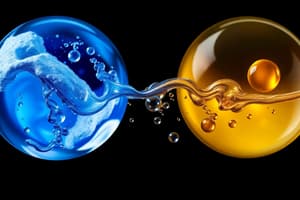Podcast
Questions and Answers
What distinguishes protons, neutrons, and electrons from one another?
What distinguishes protons, neutrons, and electrons from one another?
- Their interactions with other subatomic particles
- Their names and symbols
- Their stability and radioactive decay properties
- Their size, location within the atom, and charge (correct)
How are different types of atoms classified?
How are different types of atoms classified?
- As isotopes, which have varied numbers of electrons
- By their atomic mass, which includes protons and electrons
- By their atomic number, which represents the number of neutrons
- As elements, each with distinct chemical and physical properties (correct)
What determines the properties and characteristics of an element?
What determines the properties and characteristics of an element?
- The number of protons, neutrons, and electrons it possesses (correct)
- Its position on the periodic table, based on atomic weight
- The arrangement of its atoms in molecules and compounds
- The ratio of isotopes found naturally for that element
What is the significance of an element's atomic number?
What is the significance of an element's atomic number?
What distinguishes isotopes of an element?
What distinguishes isotopes of an element?
What determines the stability of an isotope?
What determines the stability of an isotope?
How are ions formed?
How are ions formed?
What characterizes ionic bonds?
What characterizes ionic bonds?
What are the main components of an atom's structure?
What are the main components of an atom's structure?
How is matter classified based on its composition?
How is matter classified based on its composition?
What defines an ionic compound?
What defines an ionic compound?
Which of the following best describes a compound?
Which of the following best describes a compound?
Which property is NOT characteristic of covalent compounds?
Which property is NOT characteristic of covalent compounds?
What is a molecule composed entirely of the same element also known as?
What is a molecule composed entirely of the same element also known as?
Why are pure substances unique?
Why are pure substances unique?
Which of the following is true about elements?
Which of the following is true about elements?
What differentiates a mixture from a compound?
What differentiates a mixture from a compound?
What makes molecules different from atoms?
What makes molecules different from atoms?
Which is a true statement about covalent bonds?
Which is a true statement about covalent bonds?
What is true about the existence of pure elements in nature?
What is true about the existence of pure elements in nature?
Which of the following is an example of an extensive physical property?
Which of the following is an example of an extensive physical property?
Which statement correctly describes a chemical property?
Which statement correctly describes a chemical property?
What distinguishes a liquid from a gas?
What distinguishes a liquid from a gas?
Which of the following is an example of a chemical change?
Which of the following is an example of a chemical change?
What happens during the process of condensation?
What happens during the process of condensation?
According to the Law of Conservation of Matter, what happens during both physical and chemical changes?
According to the Law of Conservation of Matter, what happens during both physical and chemical changes?
What is the primary difference between intensive and extensive physical properties?
What is the primary difference between intensive and extensive physical properties?
When a substance freezes, what change occurs?
When a substance freezes, what change occurs?
What defines the process of vaporization?
What defines the process of vaporization?
What makes gases unique among the states of matter?
What makes gases unique among the states of matter?
Flashcards
Atom
Atom
The smallest fundamental unit of matter that composes all substances.
Subatomic Particle
Subatomic Particle
A particle smaller than an atom that forms its structure, includes protons, neutrons, and electrons.
Nucleus
Nucleus
The small, dense center of an atom that contains protons and neutrons.
Electron Cloud
Electron Cloud
Signup and view all the flashcards
Element
Element
Signup and view all the flashcards
Isotope
Isotope
Signup and view all the flashcards
Ion
Ion
Signup and view all the flashcards
Cation
Cation
Signup and view all the flashcards
Anion
Anion
Signup and view all the flashcards
Ionic Bond
Ionic Bond
Signup and view all the flashcards
Physical Properties
Physical Properties
Signup and view all the flashcards
Chemical Properties
Chemical Properties
Signup and view all the flashcards
Intensive Properties
Intensive Properties
Signup and view all the flashcards
Extensive Properties
Extensive Properties
Signup and view all the flashcards
States of Matter
States of Matter
Signup and view all the flashcards
Solid State
Solid State
Signup and view all the flashcards
Liquid State
Liquid State
Signup and view all the flashcards
Gas State
Gas State
Signup and view all the flashcards
Phase Change
Phase Change
Signup and view all the flashcards
Law of Conservation
Law of Conservation
Signup and view all the flashcards
Electron
Electron
Signup and view all the flashcards
Molecule
Molecule
Signup and view all the flashcards
Compound
Compound
Signup and view all the flashcards
Ionic Compound
Ionic Compound
Signup and view all the flashcards
Covalent Compound
Covalent Compound
Signup and view all the flashcards
Properties of Compounds
Properties of Compounds
Signup and view all the flashcards
Reactivity
Reactivity
Signup and view all the flashcards
Pure Substances
Pure Substances
Signup and view all the flashcards
Mixtures
Mixtures
Signup and view all the flashcards
Study Notes
Properties of Substances
- Substances are described by properties, categorized as physical or chemical.
- Physical properties are observable without changing the substance's identity (reversible).
- Examples: color, hardness, conductivity, density.
- Physical properties can be intensive (independent of quantity) or extensive (dependent on quantity).
- Examples: odor (intensive), volume (extensive).
- Chemical properties determine a substance's reactivity with others.
- Examples: combining with other substances, changing color, emitting heat.
States of Matter
- Matter exists as solids, liquids, and gases.
- Solids: atoms packed tightly, fixed shape and volume.
- Liquids: loosely bonded atoms, indefinite shape, definite volume.
- Gases: atoms moving freely, indefinite shape and volume (compressible).
- Phase changes: transitions between states.
- Melting: solid to liquid (increased energy).
- Freezing: liquid to solid (decreased temperature).
- Vaporization: liquid to gas (increased energy).
- Condensation: gas to liquid (decreased energy).
- Changes can be physical (identity preserved) or chemical (new substances formed).
- Matter is conserved during both physical and chemical changes (Law of Conservation).
Atoms and Elements
- Atoms: basic units of matter.
- Structure: nucleus (protons, neutrons) and electron cloud.
- Subatomic particles: protons (positive), neutrons (neutral), electrons (negative).
- Atoms formed after the Big Bang.
- Elements: different types of atoms, distinct properties (determined by # protons).
- Models of the atom evolved over time.
- Atoms are submicroscopic (too small to see).
The Periodic Table
- Elements organized on the periodic table.
- Each element has an atomic number (equal to number of protons).
- Atomic number determines many element properties and reactivity.
- Elements combine to create all matter.
Isotopes
- Isotopes: different species of the same element (same atomic number, different mass).
- Characterized by Frederick Soddy (1913).
- Two main types: stable and radioactive (unstable).
- Stability determined by proton/neutron ratio.
- Monoisotopic element: only one stable isotope.
- Half-life: rate of radioactive decay.
- Isotopic abundance: proportion of isotopes in nature (measured by mass spectrometry).
- Properties:
- Same atomic number, different atomic masses.
- Same chemical properties (mostly).
- Different physical properties (often).
- Can be stable or unstable.
Ions
- Ions: atoms that have gained or lost electrons, carrying a charge.
- Cations: positive ions (lost electrons).
- Anions: negative ions (gained electrons).
- Ions can be single atoms, molecules, or compounds.
- Molecules: two or more of the same atoms bonded together.
- Compounds: two or more different atoms bonded together.
- Monoatomic ions: one-atom ions.
- Polyatomic ions: multiple-atom ions.
- Atoms maintain their internal structure (nucleus, electron shells).
- Electrons are transferred to/from atoms, but protons are not.
Ionic and Covalent Compounds
- Compounds classified as ionic or covalent.
- Ionic compounds: metal cations and nonmetal anions.
- Highly organized structures, high melting/boiling points, typically good conductors. Example: metal-nonmetal compound.
- Covalent Compounds: nonmetals sharing electrons.
- Low melting/boiling points, typically poor conductors. Example: nonmetal-nonmetal compound.
- Chemical bonds join atoms in compounds.
Mixtures and Pure Substances
- Matter classified into mixtures and pure substances.
- Pure substances contain only one type of compound per element.
- Mixtures contain two or more compounds and/or elements.
Summary of Elements, Molecules, and Compounds
- Elements: one type of atom.
- Molecules: Atoms chemically bonded (same or different).
- Bonds can be ionic or covalent.
- Compounds: two or more Different element types chemically bonded in fixed ratios.
- Classified as ionic or covalent based on bond type.
Studying That Suits You
Use AI to generate personalized quizzes and flashcards to suit your learning preferences.




